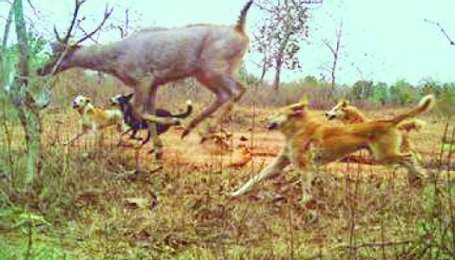NTCA issues SOP to deal with stray, feral dogs entering tiger reserves
| Date :11-Jan-2021 |

A camera trap image of stray dogs chasing sambar inside a tiger reserve. (Photo courtesy - Status of Tigers and Co-predators & Prey in India-2018).
By Kartik Lokhande :
Calls for capture and sterilisation of stray/ feral dogs from tiger reserves But, such dogs should ‘under no circumstance’ be released back into tiger reserves, states the SOP
Against the backdrop of the growing menace of stray/ feral dogs in the tiger reserves and threat they pose to the wildlife, National Tiger Conservation Authority (NTCA) has issued Standard Operating Procedure (SOP) to deal with stray/ feral dogs in tiger reserves. Under the SOP, NTCA has allowed capture and sterilisation of such dogs and their release into ‘suitable’ alternate site other than the tiger reserves. The threat of stray/ feral dogs to wildlife was clearly brought out in the report ‘Status of Tigers and Co-predators & Prey in India-2018’ released last year. The said report had assessed the ‘magnitude of anthropogenic disturbances within tiger reserves and tiger occupied areas’ using Relative Abundance Index (RAI). This RAI was obtained through camera trap images of livestock, ‘free ranging domestic dogs’, wild animals with snares, poachers with arms or poached carcasses.
“Feral dogs were detected in most tiger reserves. Dogs are a threat to ungulates (which they hunt) and to carnivores, since they carry infectious diseases like rabies, parvovirus, and distemper,” the report had pointed out. Following advisories of NTCA/Project Tiger and concerns expressed by wildlife experts, NTCA recently released the SOP to deal with stray/ feral dogs in tiger reserves. The SOP was issued ‘to ensure that stray/ feral dogs are handled in the most appropriate manner to avoid disease spread and physical injury to tiger and other wildlife, besides mortality to young and juvenile wildlife.’ It is applicable to all tiger reserves in the country, and it treats stray/ feral dogs as equivalent to street-dogs. Apart from documentation of prevalent canine diseases, NTCA has allowed capture and sterilisation of stray/ feral dogs. The dogs are to be captured by using techniques prescribed by Animal Welfare Board of India. The captured dogs are to be de-wormed and then sterilised.
Besides, they are to be vaccinated against Canine Distemper and Rabies. However, the SOP states in clear words, “Feral/ stray dogs captured from within tiger reserves should under no circumstances be released back and a suitable alternate site be selected for their rehabilitation.” As per the SOP, a committee comprising a veterinarian from Veterinary and Animal Husbandry Department, a co-opted veterinarian from NGO, local NGO representative, representative of animal welfare organisation, representative of district unit of Society for Prevention of Cruelty to Animals, representative of local Panchayat body. Deputy Director/ DFO/ DCF of respective tiger reserve shall be Chairman of the committee. The committee has been tasked with delineation of areas with movement of feral dogs and areas susceptible to ingress of stray dogs, and to map them in GIS domain. These areas are to be monitored by visual assessment for dog population. The SOP entrusts Field Director of tiger reserve with responsibility of being Local Authority as under Animal Birth Control (Dogs) Rules, 2001. The overall responsibility at the State-level would rest with the Chief Wildlife Warden
Situation in Melghat, TATR As per the ‘Status of Tigers and Co-predators & Prey in India-2018’ report, under the head of relative abundance of all photo-captured species, 2.56 photos per 100 camera trap at night were of ‘domestic dogs’ in Melghat Tiger Reserve (MTR). The number of trap nights to get one photo of domestic dogs was merely 39. It can be better understood in comparison to 11,696 trap nights taken to get one photo of Chinkara, or 7,797 nights taken to get one photo of Indian Fox, or 302 nights taken to get one photo of Chital, or 60 nights for one photo of Wild Dog, or 40 nights for one photo of Tiger in MTR. Similarly, in case of popular Tadoba-Andhari Tiger Reserve (TATR), the number of photos per 100 trap nights was 2.86 for domestic dogs. In TATR, the number of trap nights required to get single capture of domestic dogs was only 35! The number of trap nights required to get single capture of some other species was as follows: Asiatic Wild Cat -- 4,650, Golden Jackal -- 3,100, Indian Fox -- 1,163. In TATR, however, Tiger fared better than domestic dogs on this count with only 10 trap nights taken to get one photo.